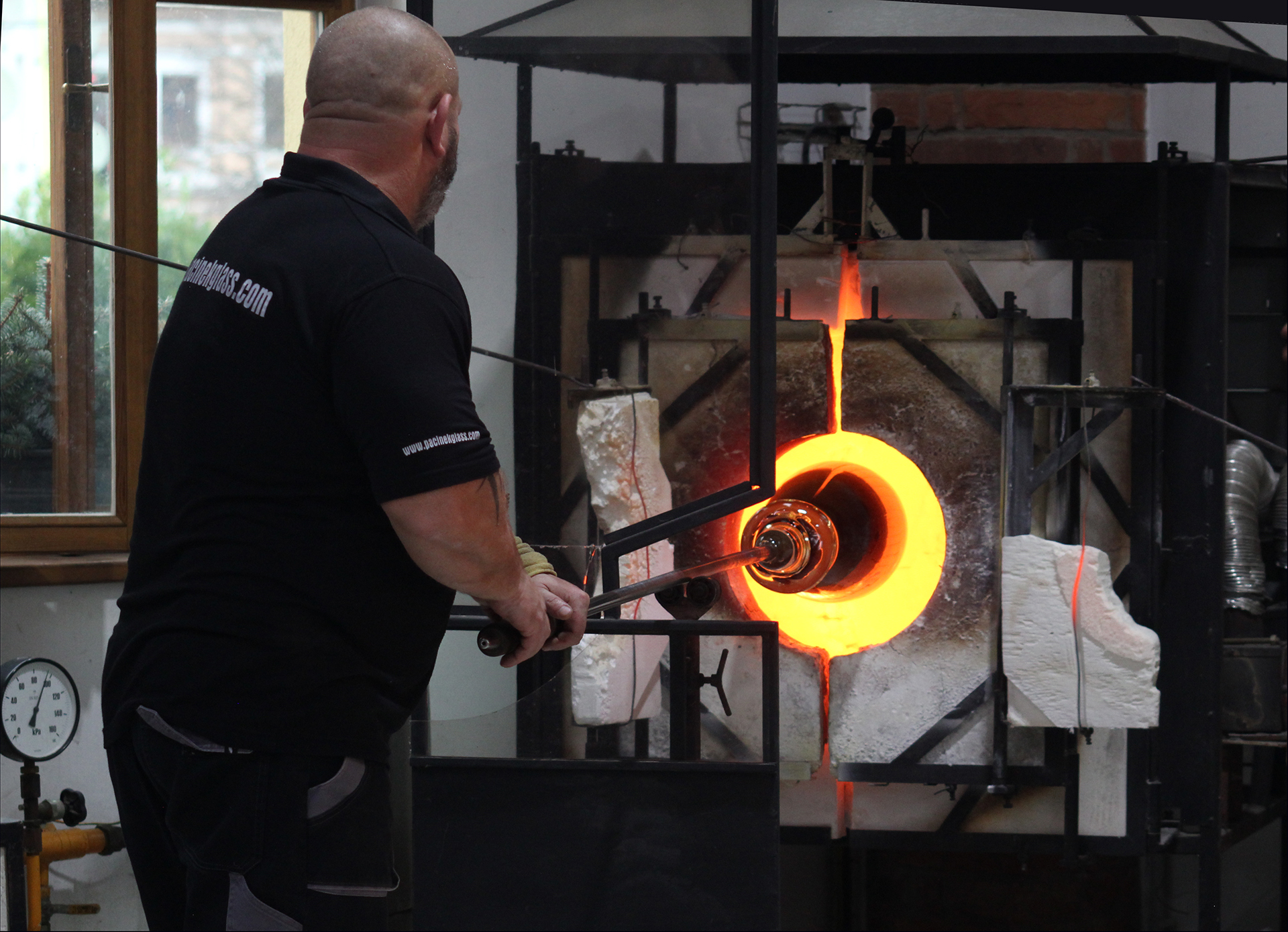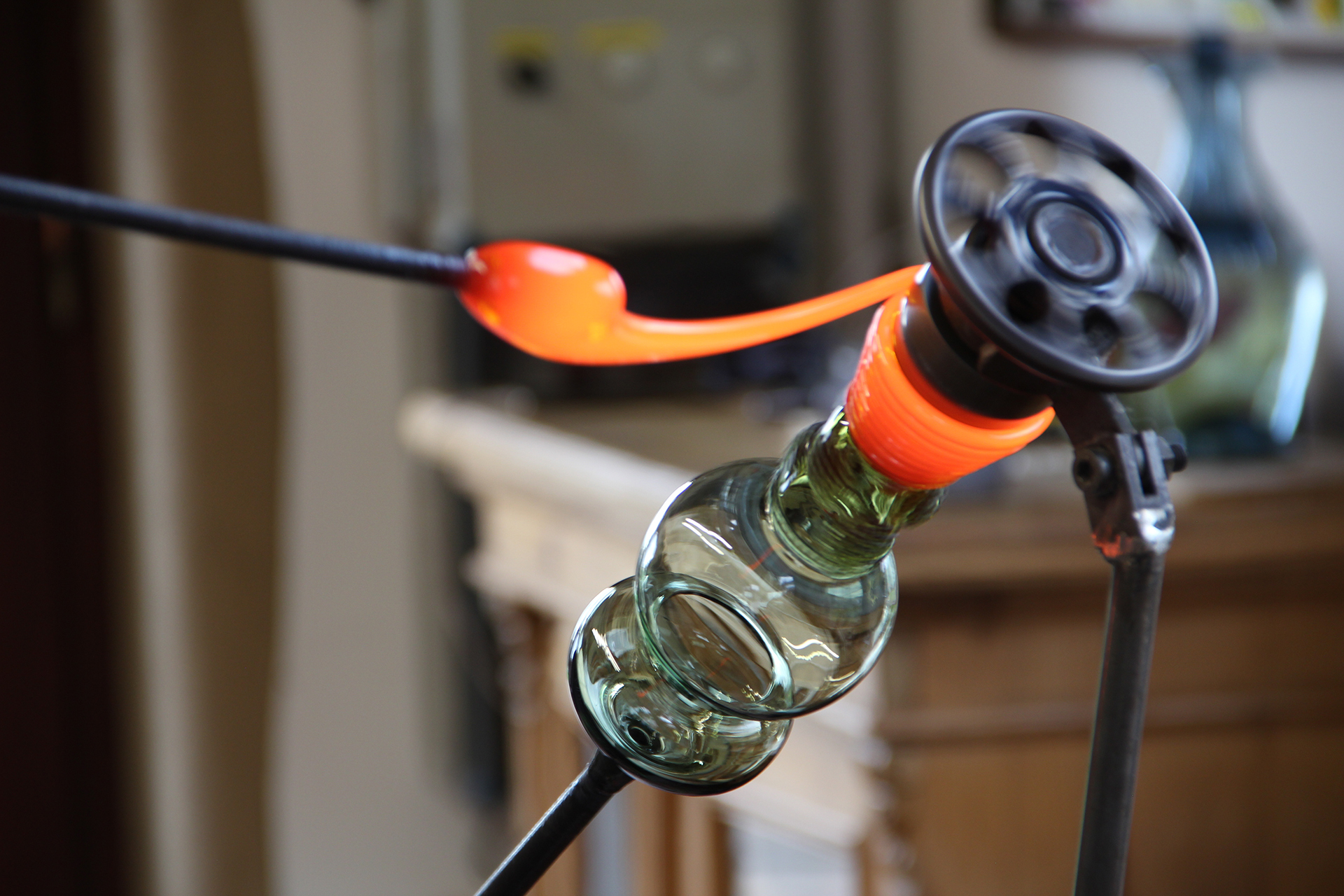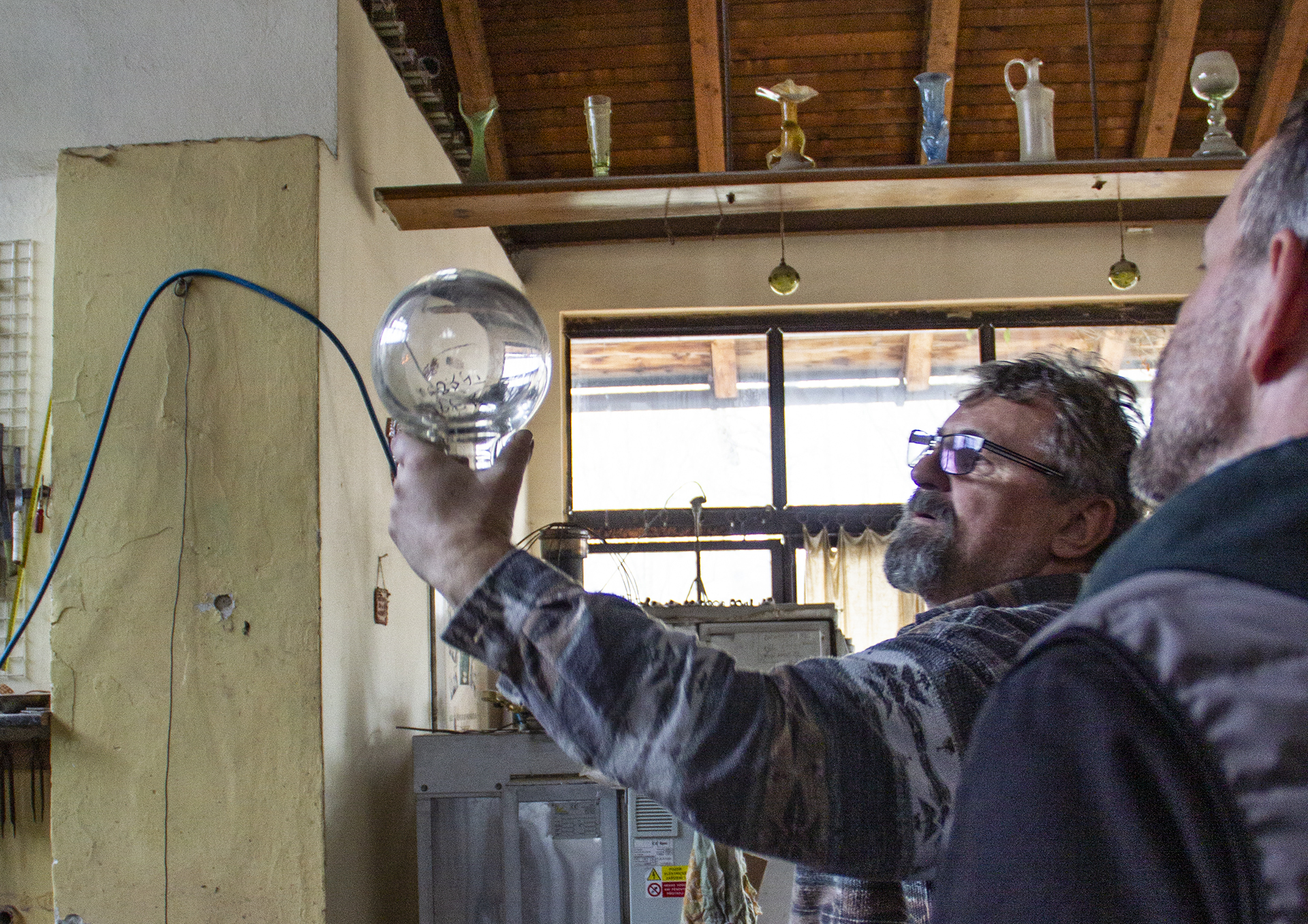
Glass
Glass
Trójstyk / Dreiländereck / Trojzemí
»A story about the glassmakers of the Lusatian Mountains«
As we step into the workshop, warm air hits us. Glassworks are in winter what museums are in summer. Men in T-shirts, shorts and sandals walk around. Three furnaces glow white and bright. On metal trestles, red-hot shapes are turned on long glassmaking pipes. The best place to be at this time.

This morning, Sven and I have an appointment with David Pastva, the director of Crystal Valley. He has set out to make the glassworks from the Lusatian Mountains and the Giant Mountains better known in the world, and today he will introduce us to a few of the smaller family businesses around Nový Bor. Each of these glassworks cultivates the traditional craft of glassmaking in its own way.
In the meantime, Jiří Pačinek has put aside the elliptical shape and points to a pallet with finished parts: "This will be a chandelier for a hotel. It will consist of several of these basic oval shapes, each with its own surface and color." Jiří Pačinek is the head of the Pačinek Glassworks in Kunratice near Cvicov. With some long-time colleagues and his family, he converted the old engine and tractor hall into a glassworks in 2015. His first workshop at the residential house in Lindava was bursting at the seams. "Here I not only have space to work with all my colleagues. In addition to the office and kitchen, there is also room for a showroom in the attic."
The three ovens are heated with gas. The lehr runs electrically. The glassworks has modern furnishings. Today it is, of course, very comfortable. In the past, several cubic meters of wood would have had to be burned every day. The slow cooling of the finished glass pieces was very problematic.
Jiří Haidl in Svojkov knows the history of glassworks in Bohemia and the technical developments very well. He became very interested in the history during his studies to become a glassblower. From him we learn that there are records of glassworks in North Bohemia since the beginning of the 15th century. Probably they have existed in the area even longer. Here they found what was needed for glass production, the right sand and enough wood. Quartz sand with the natural admixture of lime. The ash of the beeches served as plant ash. They had their huts in the forests around Nový Bor. When the wood ran out, the glassworks closed down and were rebuilt elsewhere in the forest. Even for the traders it was not always easy to find them.

Jiří Haidl follows his penchant for the traditional craft as a glassblower. In the Sklárna Svojkov, together with his son, Jakub Haidl, he makes glasses according to historical patterns. And accordingly he uses the greenish and bluish shimmering glass, because in the sand there were usually traces of iron oxide. In the past, these could not be filtered out. The crystal clear glass came to the region only later with the brothers Johann and Wenzel Fischer, who after a five-year stay in Venice and after much experimentation were able to present the famous Turnover glass in 1711. But this is just one of the stories about the history of glass production in North Bohemia.
Jiří Haidl has collected glass forms from different regions and eras during his travels through Europe and in cooperation with museums, has researched techniques and glass compositions together with historians and archaeologists. "Compared to Italian glassmakers, we use cold glass in the north. It has to be processed quickly and heated often in between."
And while we talk about glass making and techniques, many very skillful hand movements follow each other. One glass after the other is created. The counter with the wooden beads on the wall shows 22. After all the passes, the next steps and the tool that will be used next can be guessed in advance. Now a glowing blank is blown on. A short roll on a metal table. A short swing upwards, again a little bit of blowing. In the meantime, the opened mold is held ready. In it, the blank is blown into the intended shape. Father and son are perfectly attuned to each other. There is something deeply relaxing about the whole process.
In the meantime, Mrs. Haidl brings water and pastries and while I stand like this and my gaze wanders out over the countryside, I realize that I am holding one of the drinking glasses that are being created here. Created by the hands of the two glassblowers and their skills, thought through and with the concentrated knowledge of centuries.
In the workshop of the Haidls, glasses are created according to models from the Celts, from the Renaissance period, from the Bohemian royal court and the Vikings. Viking glasses are especially in demand in Scandinavia. Among them are also the only multicolored vessels. Sixty percent of Sklárna Svojkov's production goes to the north of Europe.
Just now, scissors are again used to pull a glass plug taken from the furnace into length. The pointed end is pinned to the bottom of the finished glass body. Twisting releases a uniform thread from the glowing mass. Rolled up, it creates the base of the drinking cup. It looks easy. And yet it requires a great deal of experience and skill. Shortly afterwards, the cup is ready and placed in the refrigerator. We learn that its temperature may only be 30 degrees cooler than the processing temperature of the glass. At a temperature above that, the jar would collapse. Below that, the freshly formed glass can easily crack, because it has stresses.

Unlike the Haidls, the glass artists at the Pačinek cottage work from their own designs. Jiří Pačinek loves shapes from nature, taking inspiration from it on walks. Most of all, he likes to make animals. Thus, in the showroom on the top floor, the artful representations of animals also stand out, with horses occupying a special place. Lately, however, he has taken a liking to sea creatures. Fish, aquatic plants. A lamp in the shape of a jellyfish hangs from the ceiling. These are predominantly his works. "But," he interjects, "they're mostly collaborative works." Someone has an idea or a customer comes to him with an idea, and then he and his colleagues tinker with templates and with techniques. Until the project is finalized. Then it takes up to another half a day until the workshop is set up, the preparations are complete and the work can actually start.
And with this glassmaking family, the glassworks and around it a garden has been created, a world of glass. "At first, we just put broken or unclaimed glass objects in the front garden because we didn't want to throw them away. Later, we deliberately created the garden. Planted shrubs. Planted trees." Meanwhile, the garden has grown as if into an outdoor showroom. Shimmering bluish bubbles sway in the wind, clinking softly together. A path winds down from the Dream Magic Tree, past towering ice crystals and ever-changing shrubs and huge blue blossoms to the flamingos in the now-dried riverbed. "In spring and summer, the creations made of glass go together with nature. Now the plants made of glass dominate. Sometimes they transplant some pieces to customers' gardens. This makes room for new things and the garden transforms over time." He sees the glassworks and the place as an overall experience. "From the visitor's point of view, it should be beautiful, inviting for a day trip."

Quite a lot of visitors come, tour groups and families. In the meantime, a neighbor has also joined in and rents out vacation apartments next to the garden. Another neighbor has followed his example and also renovated his house. "I'm a little afraid that I'll overrun the village because so much is changing here with the glassworks." And indeed, as you walk through the village, you'll find more sculptures and numerous details made of glass. At the entrance to the church there is also a tree made of white glass. There are candlesticks on fence posts in front of the church, and the lamp above the entrance is shaped into a flower. And the church itself houses an art collection of paintings, sculptures and vessels made of glass. An imaginative world - beautiful and inspiring.
It looks like the togetherness is succeeding. People talk about their church and they enjoy coming to the workshop - including the children. "I hope I can inspire a few of them, like I was inspired back when I was a kid. Actually, I was a wrestler, Greco-Roman style. And then they showed this series on TV. 'Jakub the Glassmaker'. I saw all the parts. And then a friend invited me to Nový Bor and we went to one of the glassworks. And then it was clear that I would become a glassmaker. Well, and then at 15 I went into apprenticeship." And as he talks, you can feel that none of his enthusiasm has been lost.
Petr Červený is one of those who started working as an independent glassmaker after the fall of communism. Until '94 he worked in one of the glass factories in Nový Bor. Some of his colleagues stayed there. He himself took the chance and founded the Florianova Hut' in Častolovice. Today, he is familiar with numerous types of making, with glass types and manufacturing processes from different eras. And that's not all. In his glassworks he employs pewterers and glass cutters, with whose help even elaborate figures, combinations of metal and glass, are possible.

After a detour to the grinding shop, we move from the office to the warehouse, then to the pewter workshop, and after a stop in front of a showcase, we finally reach the heart of the glassworks. Thus, it is also difficult for him to describe all that Florianova Hut' produces. Among Art Nouveau amphorae, classicist bowls, petroleum lamps of various origins, there are utility glasses of all kinds. Elaborate candlesticks, Art Deco vases, futuristic wall lamps, beer mugs for an anniversary, special orders from all over the world, there is probably nothing he doesn't make. In one room he shows us antique pieces, templates for replicas. He finds them at flea markets. Or customers bring him templates to order replicas. He prefers to make items according to customers' wishes, studying the different processes. When asked if he also makes glasses according to his own ideas, he waves it off. "It's all been there before. After 5,000 years, there have also already been glasses in any form."
He's in a good mood, and as he talks, it's obvious that his enthusiasm keeps presenting him with new tasks. "The workshop has been running for eleven months without a break." And in response to our questioning looks, he replies, "My second shift is about to start. My son is now loading the furnace and then the glass melting begins. Sand, lime, potash and, depending on the color, the appropriate metal oxide. We make our own glass. At one o'clock in the night, I turn up the temperature as the last operation." And with a wink, he adds, "August is free."
And while the Florianova Hut' is feverishly trying to fulfill all its customers' wishes in time for the holidays, Jiří Pačinek and his colleagues are preparing for a very special Christmas. This year, the church in Kunratice is getting a nativity scene. Mary and the child are already ready. On Christmas morning, the glassmaking family gathers in front of the furnaces to create Joseph together, before Christmas Eve begins later.

We would like to thank David Pastva for his kind support and Jiří Pačinek, Jiří Haidl, Jakub Haidl and Petr Červený for the exciting insights into their craft.
The next articles about the glass in North Bohemia will be about the leap of glass production into the world art market and the innovations in the field of glass production and the new designs, which are now again in great demand all over the world.